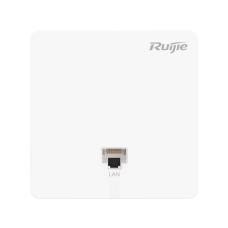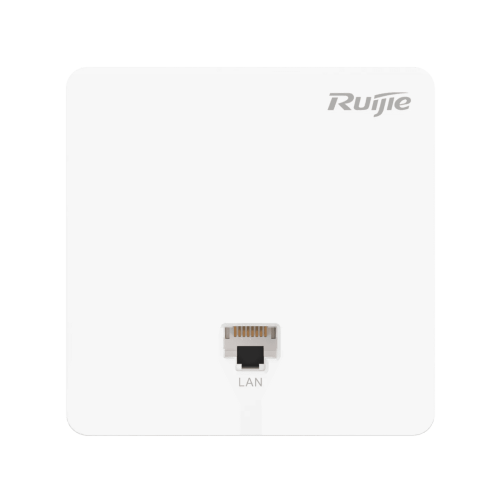RG-SAP150-SP-W, Wi-Fi 5 Dual-Radio 733 Mbps Wall-Plate Access Point Best Price In Dubai, UAE.
Availability:
In Stock
Indoor scenarios covering higher education, government, general education, finance, and commerce sectors
Highlight Features
- Cost-effective high-speed at 733 Mbps
- Enterprise-class security authentication for all-scenario protection
- WIS unified cloud management for easy O&M
Description
Key Specification
Product Overview
The RG-SAP150-SP-W is a Wi-Fi 5 wireless access point that delivers dual radios, high performance, and enterprise-grade encryption. Due to the hybrid cloud management mode and high-density access design, it is suitable for flexible deployment in high-quality network scenarios, such as classroom, dormitory, and office scenarios in the education industry, office scenarios of small- and medium-sized enterprises, outpatient clinics and office scenarios in the medical industry, and hotel apartments
Product Highlights
Cost-effectiveness and High-speed Access
Dual-band design (2.4 GHz + 5 GHz), three spatial streams throughout, and up to 733 Mbps peak data rate, with an increase in the throughput compared to 802.11n mode, providing users with a high-speed wireless access experience
RF power adjustment and intelligent channel allocation to solve the problems such as co-channel interference and adjacent channel interference, thereby improving network transmission efficiency and stability
Intelligent Networking
Local and cloud management modes, and intelligent wireless network optimization, reducing TCO and maximizing ROI Radio Resource Management (RRM) technology, avoiding signal interference between APs and between APs and interference devices, and improving user experience Intelligent local forwarding technology used to forward data that is sensitive to delay and requires real-time high-performance transmission through a wired network, greatly reducing the traffic pressure on ACs
High Security
Encrypted authentication to enhance data security, including web authentication, 802.1X authentication, MAC address authentication, and local authentication; free cloud-based authentication; multiple efficient and convenient authentication modes such as MAB authentication, and SMS- and QR code-based authentication when the AP is used with Ruijie's authentication system or multi-service AC
Network Foundation Protection Policy (NFPP) used to rate-limit or isolate attack flows to restore the network
Dynamic Frequency Selection (DFS), optimizing the use of available RF spectrum to prevent radar channel interference
Cyclic Delay/Shift Diversity (CDD/CSD), Maximum Ratio Combining (MRC), Space-Time Block Coding (STBC), and Low-Density Parity Check (LDPC), improving the signal quality, signal receiving, and reliability and performance of data transmission
Multicast-to-unicast technology to improve network security and reliability
Specifications
Hardware Specifications
| Hardware Specifications |
RG-SAP150-SP-W |
| 802.11n |
Three spatial streams ● Radio 1 – 2.4 GHz: 2x2 MIMO, two spatial streams ● Radio 2 – 5 GHz: 1x1 MIMO, one spatial streams Channels: ● Radio 1 – 2.4 GHz: 20 MHz and 40 MHz ● Radio 2 – 5 GHz: 20 MHz and 40 MHz Combined peak data rate: 600 Mbps ● Radio 1 – 2.4 GHz: 6.5 Mbps to 300 Mbps (MCS0 to MCS15 ) ● Radio 2 – 5 GHz: 6.5 Mbps to 300 Mbps (MCS0 to MCS15) Radio technologies: Orthogonal Frequency-Division Multiplexing (OFDM) Modulation types: BPSK, QPSK, 16-QAM, 64-QAM Packet aggregation: ● Aggregate MAC Protocol Data Unit (A-MPDU) ● Aggregate MAC Service Data Unit (A-MSDU) Dynamic Frequency Selection (DFS) Cyclic Delay/Shift Diversity (CDD/CSD) Maximum Ratio Combining (MRC) Space-Time Block Coding (STBC) Low-Density Parity Check (LDPC) Transmit beam-forming (TxBF) |
| 802.11ac |
One spatial streams ● Radio 2 – 5 GHz: 1x1 MIMO, one spatial streams Channels: ● Radio 2 – 5 GHz: 20 MHz, 40 MHz, and 80 MHz Combined peak data rate: 433 Mbps ● Radio 2 – 5 GHz: 6.5 Mbps to 433 Mbps (MCS0 to MCS9) Radio technologies: Orthogonal Frequency-Division Multiplexing (OFDM) Modulation types: BPSK, QPSK, 16-QAM, 64-QAM, 256-QAM Packet aggregation: ● Aggregate MAC Protocol Data Unit (A-MPDU) ● Aggregate MAC Service Data Unit (A-MSDU) Dynamic Frequency Selection (DFS) Cyclic Delay/Shift Diversity (CDD/CSD) Maximum Ratio Combining (MRC) Space-Time Block Coding (STBC) Low-Density Parity Check (LDPC) Transmit beam-forming (TxBF) |
| Antenna |
Wi-Fi ● 2.4 GHz: two built-in omnidirectional antennas, the max. antenna gain is 3 dBi. ● 5 GHz: two built-in omnidirectional antennas, the max. antenna gain is 5 dBi. |
| Port |
Uplink: 1 x 10/100Base-T auto-negotiation RJ45 Ethernet port, 802.3af/at-compliant PoE Downlink: 1 x 10/100Base-T auto-negotiation RJ45 Ethernet ports |
| Status LED |
1 x multi-color system status LED ● AP power-on status ● Software initialization status and upgrade status ● CAPWAP tunnel timeout |
| Button |
1 x Reset button ● Press the button for shorter than 2 seconds. Then the device restarts. ● Press the button for longer than 5 seconds. Then the device restores to factory settings. |
| Dimensions (W x D x H) |
Main unit: 86 mm x 86 mm x 40 mm (3.39 in. x 3.39 in. x 1.57 in.) Shipping: 125 mm x 115 mm x 60 mm (4.92 in. x 4.53 in. x 2.36 in.) |
| Weight |
Main unit: 0.1 kg (0.22 lbs) Shipping: 0.18 kg (0.40 lbs) |
| Mounting |
Mounting in 86 mm x 86 mm junction box |
| Input power supply |
PoE input over WAN/PoE |
| Power consumption |
8 W |
| Environment |
Storage temperature: –40°C to +70°C (–40°F to +158°F) Storage humidity: 5% RH to 95% RH (non-condensing) Storage altitude: < 5,000 m (16,404.20 ft.) at 25°C (77°F) Operating temperature: –10°C to +40°C (14°F to 104°F) Operating humidity: 5% RH to 95% RH (non-condensing) Operating altitude: < 3,000 m (9,842.52 ft.) at 40°C (104°F) At an altitude between 3,000 m (9,842.52 ft.) and 5,000 m (16,404.20 ft.), every time the altitude increases by 166 m (546 ft.), the maximum temperature decreases by 1°C (1.8°F). |
| Mean Time Between Failure (MTBF) |
200,000 hours (22 years) at the operating temperature of 25°C (77°F) |
| System memory |
128 MB DRAM, 32 MB flash |
| Transmit power |
2.4 GHz ● Max. transmit power: 20 dBm (100 mW) ● Min. transmit power: ? dBm (? mW) 5 GHz ● Max. transmit power: 20 dBm (100 mW) ● Min. transmit power: ? dBm (? mW) Note: The transmit power adjusted in percentage. The transmit power is limited by local regulatory requirements. |
The following table lists the radio frequency performance of Wi-Fi including different frequency bands, protocols, and date rates. It is country-specific, and Ruijie Networks reserves the right of interpretation.
| Radio Frequency Performance |
RG-SAP150-SP-W |
||
| Frequency Band and Protocol |
Data Rate |
Max. Transmit Power per Transmit Chain |
Max. Receive Sensitivity per Receive Chain |
| 2.4GHz 802.11b |
1 Mbps |
18 dBm |
–91 dBm |
| 2 Mbps |
17 dBm |
–91 dBm |
|
| 5.5 Mbps |
16 dBm |
–90 dBm |
|
| 11 Mbps |
15 dBm |
–87 dBm |
|
| 2.4GHz 802.11g |
6 Mbps |
18 dBm |
–89 dBm |
| 24 Mbps |
16 dBm |
–82 dBm |
|
| 36 Mbps |
16 dBm |
–78 dBm |
|
| 54 Mbps |
15 dBm |
–72 dBm |
|
| 2.4GHz 802.11n (HT20) |
MCS0 |
18 dBm |
–85 dBm |
| MCS7 |
15 dBm |
–67 dBm |
|
| 2.4GHz 802.11n (HT40) |
MCS0 |
18 dBm |
–82 dBm |
| MCS7 |
15 dBm |
–64 dBm |
|
| 5GHz 802.11a |
6 Mbps |
18 dBm |
–89 dBm |
| 24 Mbps |
16 dBm |
–82 dBm |
|
| 36 Mbps |
16 dBm |
–78 dBm |
|
| 54 Mbps |
15 dBm |
–72 dBm |
|
| 5GHz 802.11n (HT20) |
MCS0 |
18 dBm |
–85 dBm |
| MCS7 |
15 dBm |
–67 dBm |
|
| 5GHz 802.11n (HT40) |
MCS0 |
18 dBm |
–82 dBm |
| MCS7 |
15 dBm |
–64 dBm |
|
| 5GHz 802.11ac (VHT20) |
MCS0 |
18 dBm |
–85 dBm |
| MCS9 |
13 dBm |
–67 dBm |
|
| 5GHz 802.11ac (VHT40) |
MCS0 |
18 dBm |
–82 dBm |
| MCS9 |
13 dBm |
–57 dBm |
|
| 5GHz 802.11ac (VHT80) |
MCS0 |
18 dBm |
–79 dBm |
| MCS9 |
13 dBm |
–53 dBm |
|
Software Specifications
Basic Functions
| Basic Function |
RG-SAP150-SP-W |
| Applicable software version |
RGOS11.1(5)B0 or higher |
| WLAN |
|
| Max. number of associated STAs |
256 (up to 128 STAs per radio) ● 2.4 GHz radio: 156 STAs ● 5 GHz radio: 100 STAs |
| Max. number of BSSIDs |
16 (up to 8 BSSIDs per radio) |
| Max. number of WLAN IDs |
8 |
| STA management |
SSID hiding Band steering Each SSID can be configured with the authentication mode, encryption mechanism, and VLAN attributes independently. Remote Intelligent Perception Technology (RIPT) Intelligent STA identification technology Intelligent load balancing based on the STA quantity or traffic Rate set settings |
| STA limiting |
SSID-based STA limiting Radio-based STA limiting |
| Bandwidth limiting |
STA/SSID/AP-based rate limiting |
| CAPWAP |
IPv4/IPv6 CAPWAP Layer 2 and Layer 3 topology between an AP and an AC An AP can automatically discover the accessible AC. An AP can be automatically upgraded through the AC. An AP can automatically download the configuration file from the AC. CAPWAP through NAT |
| Data forwarding |
Centralized and local forwarding |
| Wireless roaming |
Layer 2 and Layer 3 roaming |
| Wireless locating |
MU and TAG device locating |
| Security and Authentication |
|
| Authentication and encryption |
Remote Authentication Dial-In User Service (RADIUS) PSK and web authentication QR code-based guest authentication, SMS authentication, and MAC address bypass (MAB) authentication Data encryption: WEP (64/128 bits), WPA (TKIP), WPA-PSK, WPA2 (AES), WPA3-Enterprise, WPA3-Individual |
| Data frame filtering |
Allowlist, static blocklist, and dynamic blocklist |
| WIDS |
Wireless Intrusion Detection System(WIDS) User isolation Rogue AP detection and containment |
| ACL |
Dynamic ACL assignment based on 802.1X authentication (used with the AC) |
| CPP |
CPU Protect Policy (CPP) |
| NFPP |
Network Foundation Protection Policy (NFPP) |
| Routing and Switching |
|
| MAC |
Static and filtered MAC addresses MAC address table size: 1,024 Max. number of static MAC addresses: 1,024 Max. number of filtered MAC addresses: 1,024 |
| Ethernet |
Jumbo frame length: 1,518 Full-duplex and half-duplex modes of interfaces IEEE802.1p and IEEE802.1Q |
| VLAN |
Interface-based VLAN assignment Max. number of SVIs: 40 Max. number of VLANs: 4,094 VLAN ID range: 1–4,094 |
| ARP |
ARP entry aging and proxy ARP Max. number of ARP entries: 1,024 ARP check |
| IPv4 services |
Static and DHCP-assigned IPv4 addresses NAT, FTP ALG, and DNS ALG |
| IPv6 services |
IPv6 addressing, Neighbor Discovery (ND), ICMPv6, IPv6 ping |
| IP routing |
IPv4/IPv6 static route Max. number of static IPv4 routes: 1,024 |
| Multicast |
Multicast-to-unicast conversion |
| VPN |
PPPoE client |
| Network Management and Monitoring |
|
| Network management |
NTP server and NTP client SNTP client SNMPv1/v2c Fault detection and alarm Information statistics and logging |
| Network management platform |
Web management (Eweb) |
| User access management |
Telnet and TFTP Management |
| Switchover among Fat, Fit, and cloud modes |
When the AP works in Fit mode, it can be switched to Fat mode through an AC. When the AP works in Fat mode, it can be switched to Fit mode through the console port or Telnet mode. When the AP works in cloud mode, it can be managed through Ruijie Cloud. |






Reviews (0)